
Bioprinter to serve as an educational tool
USD’s biomedical engineering program recently purchased a 3D bioprinter to use for research in their new undergraduate program.
This printer, in addition to the uv flatbed printers, is the third 3D printer the department owns. However, this one is unique as it is the only 3D bioprinter that could eventually be used to print tissues. These tissues could be used to replace infected tissues within the body.
Daniel Engebretson, chair of the biomedical engineering program, said being able to replace tissues will be a long process.
“We are very new to the bioprinting space, and we don’t have many people who are active in it. We literally just got this bioprinter a couple months ago and we are still very much in the playing-with-it stage,” Engebretson said. “What we envision is vascular tissues. If you need to replace a blood vessel in somebody, you can print it out and sew it in. There is nothing even close to being in the market yet for that. We are probably 10, 15 or 20 years from that.”
Eventually, the printer will be used as an educational tool and people will also start using 3D printing guides with elevated technologies. Engebretson said their driving reason for purchasing the printer was because of the new undergraduate program.
“This will be a tool that is going to be a part of (the student) experience. That’s the biggest driver for us so we could get something that we could have undergraduates using,” he said. “These sorts of products are going to be out there 10, 15 years in the future so we need to be getting students trained and doing it now. This is what undergrads need to be learning as they head out into the real world and get real jobs. ”
There are around 1,000 printers in the world that can produce tissue, Engebretson said, and only one in South Dakota.
Joni Johnson, executive director of South Dakota Biotech, said having the only bioprinter at USD will elevate the biomedical engineering program.
“This gives USD tools for the biomedical engineering program that other universities have or don’t have,” she said. “It kind of separates us from others. Students who want to go into these careers have the technology to do that research right here in South Dakota instead of not being able to do it.”
Because biomedical engineering is a broad field of study, USD targets its research specifically towards vascular tissue and how to transport therapeutic drugs to specific cells in the human body.
The bioprinter will help further develop how medical professionals can heal broken vascular tissues.
“When our vascular tissue starts to fail because they get clotted up due to the wonderful Western diet that we have and there aren’t very many good synthetic replacements for that. So what they tend to do is say you don’t need that artery over there and move it over here where it’s more important,” Engebretson said. “Well obviously it was over there for a reason so by having this synthetic tissue, you don’t have to do that you could actually grow new tissue. We can grow a new tissue to replace the diseased tissue.”
Engebretson said people have misunderstood what the printer will really be able to do.
“It’s really easy to say what they (can’t do). We don’t print cells. We are not making anything from something that isn’t alive,” Engebretson said. “We can use cells and other biological material so you can start to build tissues that way. It allows a nice way to mix the pieces together to make something that at least has the potential to be something functional.”
